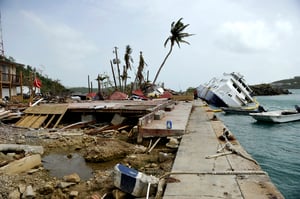 With the start of summer comes hurricane season, but natural disasters—from blizzards to earthquakes—can disrupt daily life year round. The impact of natural disasters can be far-reaching and disrupt utilities and city operations. Floods, whether caused by snowmelt, hurricane, downpour or infrastructure damage, can quickly overwhelm collection systems and damage electric pump services. And earthquakes can destroy underground infrastructure in mere minutes.
With the start of summer comes hurricane season, but natural disasters—from blizzards to earthquakes—can disrupt daily life year round. The impact of natural disasters can be far-reaching and disrupt utilities and city operations. Floods, whether caused by snowmelt, hurricane, downpour or infrastructure damage, can quickly overwhelm collection systems and damage electric pump services. And earthquakes can destroy underground infrastructure in mere minutes.
Water and wastewater utilities must take steps to protect their infrastructure from damage during natural disasters and ensure they have a recovery plan should the worst occur. The EPA provides excellent resources for emergency response planning, including the All-Hazard Consequence Management Planning for the Water Sector.
This document introduces Consequence Management Plans, which “complement a utility’s overall emergency preparedness, recovery, and response planning.” Emergency response plans are created for specific events, such as a hurricane or earthquake. In contrast, consequence management planning focuses on “addressing the problems (or consequences), such as loss of power” that result from that event.
Consequence management plans initially look beyond the cause of a problem and seek to solve or mitigate the consequences. Focusing on solving problems first and locating causes second ensures that, when a major emergency occurs, the severity of its impact is reduced and disruptions are addressed as quickly as possible.
Building an All-Hazard Consequence Management Plan follows several standardized steps:
- Know: Identify possible incidents and determine which are of highest risk and probability. Identify and implement actions to mitigate the consequences of those high-risk, high probability incidents. Identify mitigation measures to incorporate into a recovery plan.
- Connect: Learn emergency protocols for local emergency responders. Build relationships with key response partners. Supply copies of emergency plans and important information to response partners.
- Identify: Establish a chain of command and line of succession plan. Identify primary and alternate staff for key positions. Establish protocols to collect and manage incident information.
- Ensure: Develop procedures to identify and document damage, needed resources and timelines for recovery. Identify minimum resources to maintain essential services and key interdependencies with other sectors. Establish policies to authorize expenditures for supplies and increase amount of cash on hand during an incident.
A consequence management plan should be thorough and exact. For more details on building a plan or preparing for specific incidents, check out the resources from the EPA below:
- Learn how to build an All-Hazard Consequence Management Plan and identify specific procedures for difference incidents.
- Learn about mutual aid and assistance programs and find out how to join.
- Explore the EPA’s drinking water and wastewater utility response protocol toolbox.
Envirosight is committed to ensuring that your community stays strong during natural disasters and when tackling day-to-day operations. Let us help you keep safety and best practices in view at all times with our FREE Safety Poster Pack. It has three safety posters that cover health and hygiene, traffic safety and confined space entry!
Photo courtesy of Petty Officer 2nd Class Matthew S. Masachi via Department of Defense

